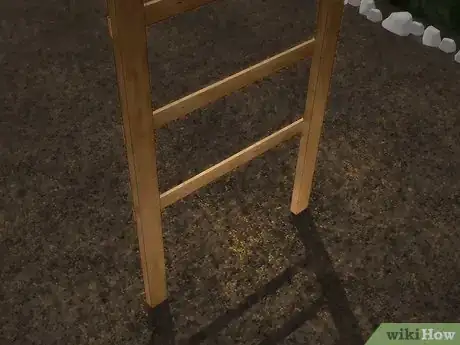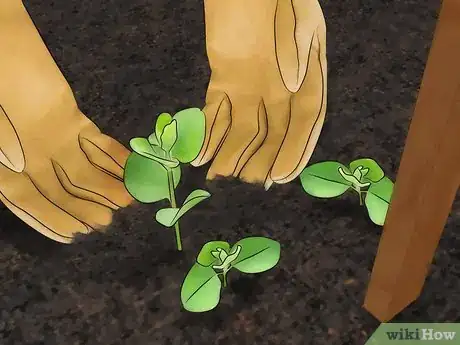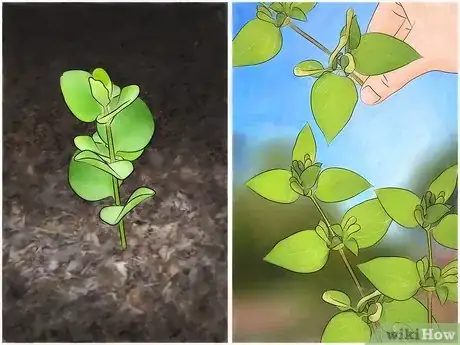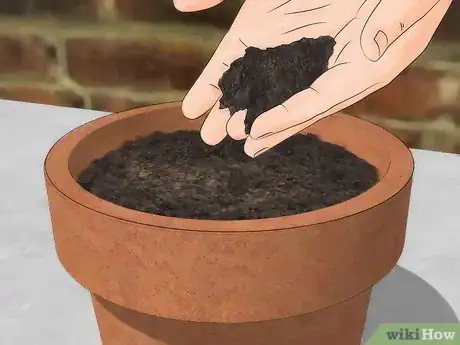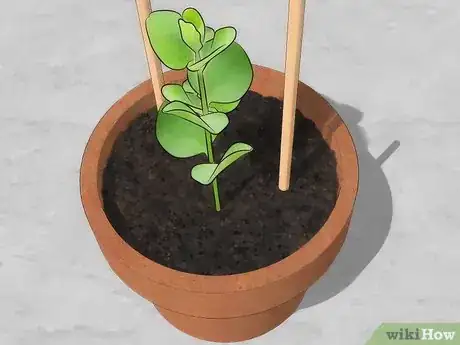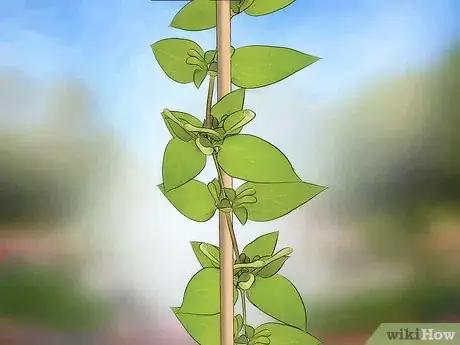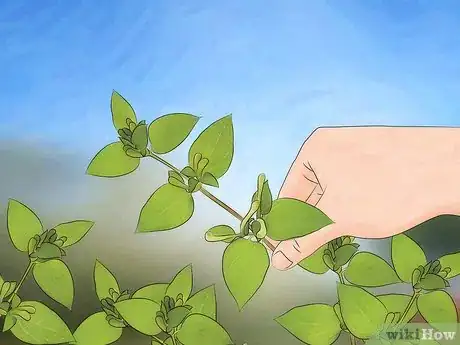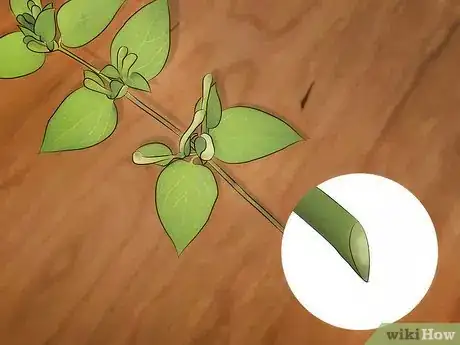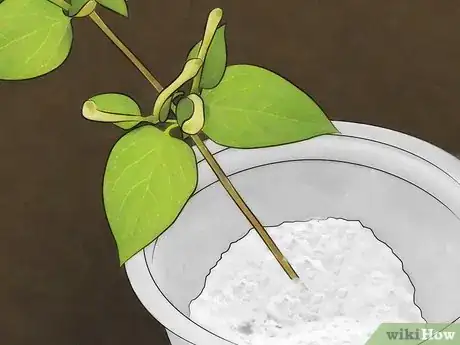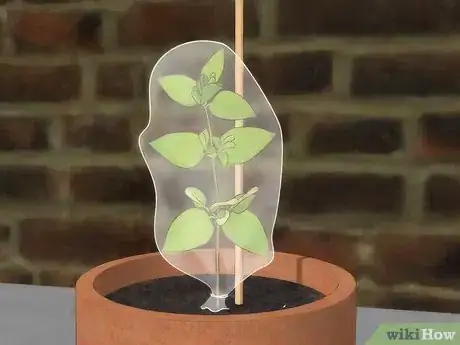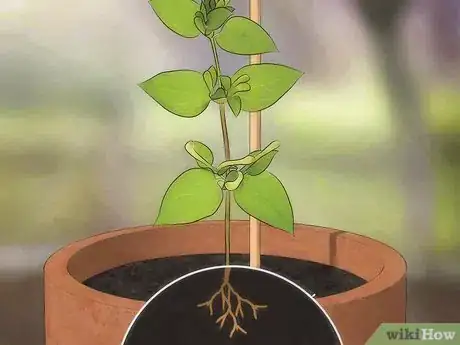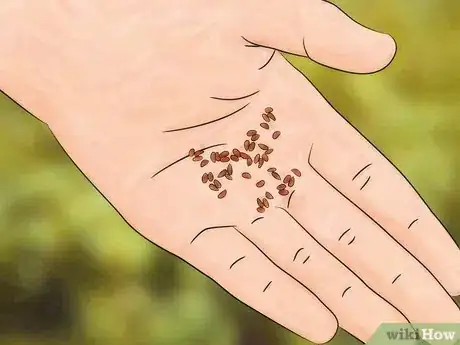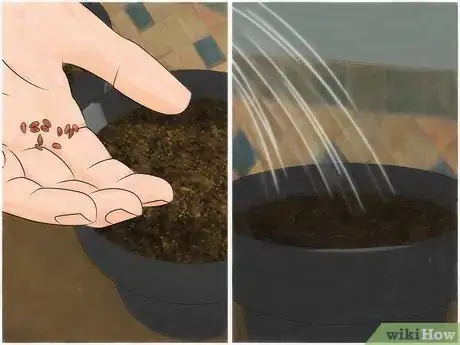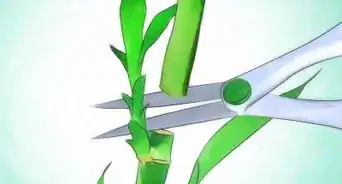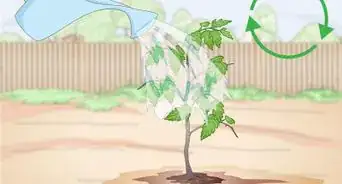This article was co-authored by Maggie Moran. Maggie Moran is a Professional Gardener in Pennsylvania.
wikiHow marks an article as reader-approved once it receives enough positive feedback. In this case, 94% of readers who voted found the article helpful, earning it our reader-approved status.
This article has been viewed 241,622 times.
Honeysuckle is a low maintenance plant. It is available in two varieties: a fragrant climbing honeysuckle or a beautiful woody shrub. Both varieties require full sunshine and yield glorious flowers in yellows, golds, whites, pinks, and reds. The climbing variety is often trained to grow up fences, walls, trellises, and stakes.
Steps
Planting Honeysuckle in Your Garden
-
1Select a sunny, moist spot. While honeysuckle plants can tolerate partial-shade, they flourish in the sun. If possible, choose to plant your honeysuckle in a location that receives full sun. The site you choose should also have soil that retains some moisture—excess water should drain off.[1]
- Without sunshine, honeysuckle plants will not flower profusely and they may shed their leaves.[2]
-
2Install supports for your plants if needed. Once you have selected the location, determine if the plant will serve as ground cover or if the honeysuckle will climb up a support structure. If you intend to use the plant as ground cover, you will not need to install a support structure. If you would like to train the honeysuckle to climb, you will either need to plant it near an existing wall or fence, or install a trellis, stakes, wall, or fence. If you are not planting your honeysuckle near an existing fence or wall, Insert the support structure into the ground prior to planting the honeysuckle.
- If you install the structure after placing the plant in the ground, you may damage the root system.[3]
Advertisement -
3Plant the honeysuckle in the early spring. After the threat of frost has passed in the spring, you may plant the honeysuckle in your garden. If you are using the honeysuckle as ground cover, plant them between two and five feet apart. If you are training your honeysuckle, place each plant six to twelve inches away from the support structure and three to fifteen feet away from other plants.[4]
- Dig a hole as deep as the plant's current root system. The hole should be two to three times wider than its container.
- Combine new compost into the soil you removed from the hole.
- Remove the honeysuckle from its container without damaging the root system.
- Loosen the plant's soil with your fingertips before placing it in the hole.
- Scoop half of the soil-compost mixture into the hole. Water the area to remove unwanted air pockets. Allow all of the water to drain.
- Fill in the rest of the hole with soil-compost mix.
- Water your transplanted honeysuckle thoroughly.
- If you are training your honeysuckle, attach the plant to the support structure with old nylon hosiery tied in a figure eight. The crossed part of the tie should lay between the stem and the support structure.[5]
-
4Care for your honeysuckle. There are several actions you can take to ensure the health and prosperity of your honeysuckle plant. These include:
- Immediately after planting, cover the base of the honeysuckle with a two-inch layer of compost, followed by a layer of mulch. The mulch will help the soil retain water.
- If your region receives less than one inch of rain per week, water the honeysuckle plant.
- After your honeysuckle has flowered, prune the plant.[6]
Planting Honeysuckle in Containers
-
1Find a large container. When you plant honeysuckle in a container, the pot must be large enough to accommodate the plant's growing root system. Select a container that is two to three times larger than the honeysuckle's current pot.
- If you intend to install a support system within the pot, the container will also have to accommodate for the trellis or stakes.[7]
-
2Plant the honeysuckle in the container. Fill your large pot approximately halfway full of soil and/or compost. Carefully remove the honeysuckle from its plastic container without damaging its root system. Insert the plant into the large pot so that the base of the plant sits flush with the lip of the container. Fill in the empty space with more soil and/or compost.
- If you need to elevate the honeysuckle, add more soil or compost to the pot until the plant's base reaches the lip of the container.[8]
- The type of honeysuckle you choose to plant is dependent upon the size of the container you wish to use, the climate of your region, and availability at local nurseries, markets, and stores. Before you purchase a honeysuckle, make sure the variety is not considered invasive.
-
3Install a support system. In order to train your honeysuckle to climb, you must provide it with a support structure. You may position the container next to a south-facing wall or fence. If this option is not available to you, you may install a trellis or set of stakes within the pot itself.
- You can create a makeshift cage out of three bamboo dowels and nursery wire. Insert the three dowels along the inner edge of the container at even intervals. Wrap a piece of nursery wire around the top of the three dowels. Cover the rest of the structure—from its top to its base—with five to seven rings of nursery wire.
-
4Train your honeysuckle. Once your structure is in place, you can train the plant to climb up the trellis, stakes, wall, or fence. Wrap the plant's vines around the support structure. You can attach the honeysuckle to the structure with old nylon hosiery.[9]
- If you have not already done so, move the honeysuckle to a sunny location and water the plant.
Propagating Honeysuckle from Cuttings
-
1Take cuttings from a honeysuckle plant. You can start a new honeysuckle plant from a cutting, or portion of an existing plant, treated with root hormone. Remove six to eight inch pieces of vine from your honeysuckle plant with a sharp knife. The cut you make should be slanted as opposed to straight across. If possible, separate the cutting from the vine just below a leaf node, or the portion of the stem that produces leaves. Remove the lowest two sets of leaves.
- Take your cuttings from a plant that is at least two years old.[10]
-
2Remove the stem's outer layer. With a knife, carefully scrape off the top layer of the stem. You do not need to remove the entire layer, only the portion that spans from the base of the cutting to the lowest leaf node. This distance will be approximately two inches.
- This step is optional and should be avoided if you do not have a steady hand.[11]
-
3Treat the cuttings with root hormone. Root hormone is used to enhance the growth of plant's roots. Place a small amount of powder or liquid root hormone into a clean disposable dish. Dip two inches of the cutting into the root hormone. Tap the excess product off on the side of the dish.[12]
- Root hormone is commonly used on cuttings, like honeysuckle, that generate roots rather slowly.
-
4Plant and cover your cutting. Fill a small container with fresh soil or compost. Insert the cutting two inches into the fresh soil. Stick a bamboo skewer into the soil approximately half an inch away from the cutting. Water the cutting. Cover the plant with a plastic bag and seal the bag with a rubber band.
- The bamboo stick with keep the bag off of the cutting.[13]
-
5Let your honeysuckle take root. Once the cuttings are planted, relocate the containers to a bright, sunny sport. Within two to three weeks, the cuttings should produce roots. To check their progress, lightly tug on the cutting to see if it is attached to the soil. When the roots are at least one inch long, you may transplant them to a larger pot or into your garden.
- Don't forget to water your cuttings. The soil should remain moist, not damp or dry.[14]
-
6Monitor your new plants for disease and pests. Honeysuckles are susceptible to certain diseases and pests. The most common of these are powder mildew and aphids. Watch your honeysuckles closely to look for molding, mildew, bite marks, and other damage that could indicate a problem with your new plant.
- Powder mildew attacks plants that don't have sufficient water. Prevent it by watering your plant regularly and keeping the soil moist and well drained.
- Aphids feed on the leaves of the plant. They are typically treated with insecticide soaps for large infestations. However, if you only have a few of them you can spray them away with a garden hose.
- Other insects, including scale insects, spider mites, and caterpillars, can also impact your honeysuckles. You will need to remove any pests and eggs, using insecticide as necessary, along with removing injured leaves.
Sowing Honeysuckle Seeds
-
1Purchase or collect honeysuckle seeds. Honeysuckle seeds are not available in every region, at every nursery, or through every seed catalogue. If you can not find a supplier and you have access to a honeysuckle plant, you may collect the seeds directly from the spent flowers.
- Honeysuckle seeds are found in pods. When the pods become dry and brittle, they are ready for harvest. Ripe pods should snap off the stem and split a small amount when squeezed.
-
2Dry the seeds. After harvesting the pods, the wet seeds need to dry. Dry the seeds in a well ventilated room. The room should be kept at a temperature between 70 and 95℉. After two to six weeks, the seeds will be ready to plant.
- You can dry the seeds in a closed paper bag, an open plastic cup, or a mixing bowl covered with a piece of screen, lightweight fabric, or cheesecloth.
-
3Plant the seeds. Fill a small container with moist perlite soil. Sprinkle or place the seeds on top of the soil. Water the seeds immediately. The seeds will germinate within fifteen days.
- The seeds must be wet to germinate, or transform from a seed to a seedling. Check the soil every day to determine if the seeds need additional water.[15]
Expert Q&A
Did you know you can get expert answers for this article?
Unlock expert answers by supporting wikiHow
-
QuestionCan you grow honeysuckle from a cutting?
 Lauren KurtzLauren Kurtz is a Naturalist and Horticultural Specialist. Lauren has worked for Aurora, Colorado managing the Water-Wise Garden at Aurora Municipal Center for the Water Conservation Department. She earned a BA in Environmental and Sustainability Studies from Western Michigan University in 2014.
Lauren KurtzLauren Kurtz is a Naturalist and Horticultural Specialist. Lauren has worked for Aurora, Colorado managing the Water-Wise Garden at Aurora Municipal Center for the Water Conservation Department. She earned a BA in Environmental and Sustainability Studies from Western Michigan University in 2014.
Professional Gardener
-
QuestionHow is honeysuckle spread?
 Lauren KurtzLauren Kurtz is a Naturalist and Horticultural Specialist. Lauren has worked for Aurora, Colorado managing the Water-Wise Garden at Aurora Municipal Center for the Water Conservation Department. She earned a BA in Environmental and Sustainability Studies from Western Michigan University in 2014.
Lauren KurtzLauren Kurtz is a Naturalist and Horticultural Specialist. Lauren has worked for Aurora, Colorado managing the Water-Wise Garden at Aurora Municipal Center for the Water Conservation Department. She earned a BA in Environmental and Sustainability Studies from Western Michigan University in 2014.
Professional Gardener
-
QuestionHow tall will a honysuckle grow?
 Community AnswerThey can grow over 10 feet per season once they are established.
Community AnswerThey can grow over 10 feet per season once they are established.
Warnings
- Make sure the type of honeysuckle you wish to plant is not considered invasive n your region.⧼thumbs_response⧽
Things You'll Need
- Honeysuckle plant, cuttings, or seeds
- Trellis, stakes, fence, or wall
References
- ↑ http://garden.org/plantguide/?q=show&id=2096
- ↑ https://www.greenandvibrant.com/honeysuckle-vines
- ↑ http://www.thegardenhelper.com/honeysucklecare.html
- ↑ http://www.thegardenhelper.com/honeysucklecare.html
- ↑ http://garden.org/plantguide/?q=show&id=2096
- ↑ http://garden.org/plantguide/?q=show&id=2096
- ↑ https://www.youtube.com/watch?v=TtfBd_I7ZC4
- ↑ https://www.youtube.com/watch?v=TtfBd_I7ZC4
- ↑ http://www.thegardenhelper.com/honeysucklecare.html
About This Article
If you want to grow honeysuckle in your garden, select a sunny spot where the ground retains some moisture after a heavy rain, but does not flood. If you want the honeysuckle to climb, either pick a spot near a fence or a wall or build a trellis, and place the plants 6-12 inches away from the support structure and 3-15 feet away from other plants. Plant the honeysuckle in the early spring, after the threat of frost has passed. If you are using the honeysuckle as ground cover, plant them 2-5 feet apart. Plant the honeysuckle in the early spring, after the threat of frost has passed. Keep reading for tips from our horticulture reviewer on how to grow honeysuckle in containers!

